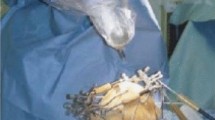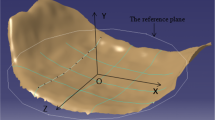Abstract
Artificial cervical disc replacement surgery has become an effective and main treatment method for cervical disease, which has become a more common and serious problem for people with sedentary work. To improve cervical disc replacement surgery significantly, a 6-DOF parallel bone-grinding robot is developed for cervical bone-grinding by image navigation and surgical plan. The bone-grinding robot including mechanical design and low level control is designed. The bone-grinding robot navigation is realized by optical positioning with spatial registration coordinate system defined. And a parametric robot bone-grinding plan and high level control have been developed for plane grinding for cervical top endplate and tail endplate grinding by a cylindrical grinding drill and spherical grinding for two articular surfaces of bones by a ball grinding drill. Finally, the surgical flow for a robot-assisted cervical disc replacement surgery procedure is present. The final experiments results verified the key technologies and performance of the robot-assisted surgery system concept excellently, which points out a promising clinical application with higher operability. Finally, study innovations, study limitations, and future works of this present study are discussed, and conclusions of this paper are also summarized further. This bone-grinding robot is still in the initial stage, and there are many problems to be solved from a clinical point of view. Moreover, the technique is promising and can give a good support for surgeons in future clinical work.


















Similar content being viewed by others
References
Huang M J (2013) Anterior Cervical Decompression and Fusion. Springer, New York
Obernauer J, Landscheidt J, Hartmann S et al (2016) Cervical arthroplasty with ROTAIO® cervical disc prosthesis: first clinical and radiographic outcome analysis in a multicenter prospective trial. BMC Musculoskelet Disord 17(1):1–7
Zhao Y, Zhang Y, Sun Y, et al. (2016) Application of cervical arthroplasty with Bryan cervical disc: 10-year follow-up results in China. Spine, 41(2).
Bartels R. A. Baaj, P.V. Mummaneni, J.S. Uribe, A.R. Vaccaro, M.S. Greenberg (eds): Handbook of spine surgery. Acta Neurochir, 2016:1–1.
Wagner SC, Kang DG, Helgeson MD (2016) Traumatic migration of the Bryan cervical disc arthroplasty. Global Spine Journal 6(1):e15–e20
Shweikeh F, Amadio JP, Arnell M et al (2014) Robotics and the spine: a review of current and ongoing applications. Neurosurg Focus 36(3):E10–E10
Taylor RH, Mittelstadt BD, Paul HA, Hanson W, Kazanzides P, Zuhars JF, Williamson B, Musits BL, Glassman E, Bargar WL (1994) An image-directed robotic system for precise orthopaedic surgery. Calixarenes in the Nanoworld 10(3):151–172
Petermann J, Kober R, Heinze J (2000) Computer-assisted plan and robot-assisted surgery in anterior cruciate ligament reconstruction. Oper Tech Orthop 10(1):50–55
Wolf A, Jaramaz B, Lisien B et al (2005) MBARS: mini bone-attached robotic system for joint arthroplasty. International Journal of Medical Robotics & Computer Assisted Surgery 1(2):101–121
Song S, Mor A, Jaramaz B (2009) HyBAR: hybrid bone-attached robot for joint arthroplasty. International Journal of Medical Robotics & Computer Assisted Surgery 5(2):223–231
Cobb J, Henckel J, Gomes P et al (2006) Hands-on robotic unicompartmental knee replacement: a prospective, randomised controlled study of the acrobot system. Journal of Bone & Joint Surgery British Volume 88(2):188–197
Barzilay Y, Liebergall M, Fridlander A et al (2006) Miniature robotic guidance for spine surgery—introduction of a novel system and analysis of challenges encountered during the clinical development phase at two spine centres. International Journal of Medical Robotics & Computer Assisted Surgery 2(2):146–153
Togawa D, Kayanja MM, Reinhardt MK et al (2007) Bone-mounted miniature robotic guidance for pedicle screw and translaminar facet screw placement: part 2—evaluation of system accuracy. Neurosurgery 60(1):5
Lefranc M, Peltier J (2015) Accuracy of thoracolumbar transpedicular and vertebral body percutaneous screw placement: coupling the Rosa ®, spine robot with intraoperative flat-panel CT guidance—a cadaver study. J Robot Surg 9(4):1–8
Chenin L, Peltier J, Lefranc M (2016) Minimally invasive transforaminal lumbar interbody fusion with the ROSATM spine robot and intraoperative flat-panel CT guidance. Acta Neurochir:1–4
Yu W, Chao Y, Zhang FQ et al (2007) Application of the bi-planar navigation robot system in different orthopedic indications. Robot 29(3):200–206
Sun LN, Jian Z, Zhi-Jiang DU (2006) An image guided orthopedic surgery robot system. Journal of Harbin Engineering University
Su W, Zhang Y, Li D (2010) Application and overview of image guided surgery system. Chinese journal of medical instrumentation:34(4)
Luo H, Jia F, Zheng Z, et al. An IGSTK-based surgical navigation system connected with medical robot[C]// Information Computing and Telecommunications (YC-ICT), 2010 I.E. Youth Conference on. IEEE, 2010:49–52.
Zijian Z, Wu X, Yuncai L, Hongjian L (2006) Robot-assisted total knee replacement surgery systems and technology [J]. Chin J Biomed Eng 25(4):461–464
W. Yongfeng, Y. Hongjian, D. Zhijiang, et al. Structure optimization of a bi-planar parallel mechanism for spine surgeries[C]// Seventh International Conference on Measuring Technology and Mechatronics Automation. IEEE, 2015.
Patel AA, Whang PG, Vaccaro AR (2008) Overview of computer-assisted image-guided surgery of the spine. Seminars in Spine Surgery 20(3):186–194
Zheng G, Nolte L P. Computer-assisted orthopedic surgery: current state and future perspective. 2015, 2(10).
Abraham ZN, Wolf A, Choset H (2006) A potential function approach to surface coverage for a surgical robot. Computer Aided Surgery Official Journal of the International Society for Computer Aided Surgery 11(1):1–9
Guven Z Y, Barkana D E. Bone cutting trajectory generation using a medical user interface of an orthopedical surgical robotic system [J]. Human System Interactions (HSI), 2010 3rd Conference on2010, pp.325–330.
Z Sugita N, Nakano T, Abe N, et al. (2011) Toolpath strategy based on geometric model for multi-axis medical machine tool. CIRP Ann Manuf Technol 60(1):419–424
Goffin J, Casey A, Kehr P et al (2003) Preliminary clinical experience with the Bryan cervical disc prosthesis. J Neurosurgery 53(3):840–845
Carricato M, Gosselin C (2009) A statically balanced Gough/Stewart-type platform: conception, design and simulation. Journal of Mechanisms & Robotics 1(3):403–421
Acknowledgements
The authors would like to express appreciation to financial supports from China Postdoctoral Science Foundation Funded Project (2016M602164), Qingdao Postdoctoral Researchers Applied Research Project (2016119), and Qingdao Application Foundation Research Project (Youth special) (14-2-4-120-jch).
Author information
Authors and Affiliations
Corresponding author
Rights and permissions
About this article
Cite this article
Tian, H., Wang, C., Dang, X. et al. A 6-DOF parallel bone-grinding robot for cervical disc replacement surgery. Med Biol Eng Comput 55, 2107–2121 (2017). https://doi.org/10.1007/s11517-017-1648-4
Received:
Accepted:
Published:
Issue Date:
DOI: https://doi.org/10.1007/s11517-017-1648-4




